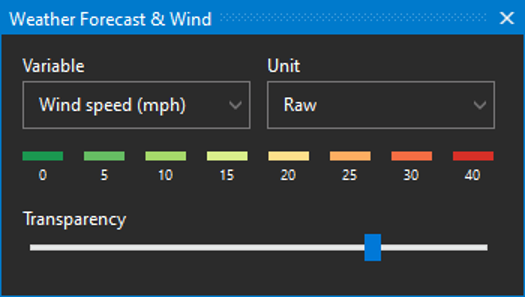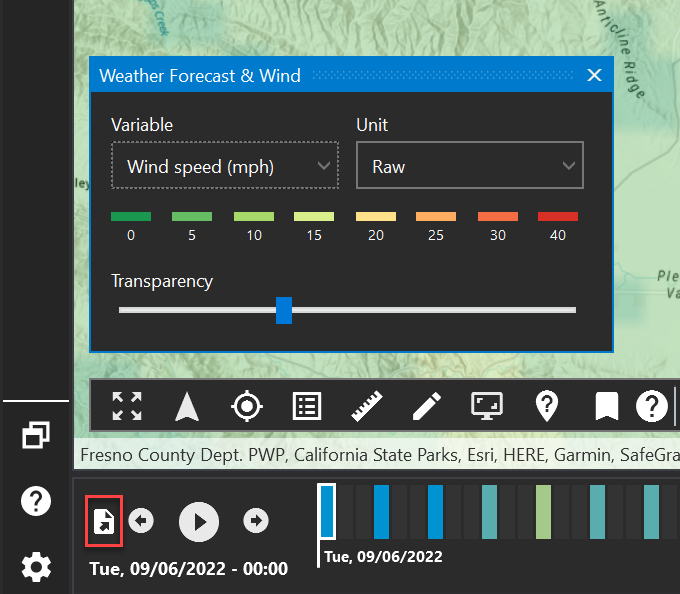Viewing Weather Forecasts

This tool allows you to view the weather forecast for the selected date/time on the timeline.
View a Weather or Wind Forecast

Select a variable from the Variable drop menu
Weather forecasts can be viewed in Percentiles or Raw units
Use the transparency slider to adjust transparency for the selected layer
Use the timeline controls to animate the weather forecast layer (play button or forward/backward buttons)
Export a Weather or Wind Forecast

Weather variables can also be exported to KMZ for viewing in Google Earth.
Select a forecast variable, such as Wind Speed
Press the Export to KMZ button on the Timeline
Wait for a notification to appear in the bottom right corner that the export process is complete
Weather Forecast & Wind Variables
Note: not all variables may be available on your version of WFA.
Wind Speed (mph): Wind speed is an hourly snapshot of the wind at 10 meters above ground level across the territory.
Moisture 1h (%): 1-hr fuels are the fine dead fuels, with diameters less than 0.25”, such as grasses. The moisture contents of 1-hr fuels respond quickly (within minutes) to changing weather conditions.
Moisture 10h (%): 10-hr fuels are small dead fuels, with diameters ranging from 0.25” to 1”. The moisture contents of 10-hr fuels respond quickly to changing weather conditions, but not as quickly as the 1-hr fuels.
Moisture 100h (%): 100-hr fuels are standard dead fuels, with diameters ranging from 1” to 3”. Due to the larger size, the moisture content of 100-hr fuels respond slower to changing weather conditions. 100-hr fuels can be used to estimate the average moisture content of the forest floor.
Temperature: Forecasted hourly snapshots of the air temperature two meters above ground level.
Relative humidity: Forecasted hourly snapshots of the relative humidity two meters above ground level. Relative humidity is a measure of how much water vapor is in the air compared to the maximum amount possible.
Woody LFM: Woody Live Fuel Moisture (shrubs and trees).
Herbaceous LFM: Herbaceous Live Fuel Moisture (primarily grasses).
The live fuel moisture products are derived from a machine learning model that ingests satellite observations and in-situ observations. The metrics are updated weekly for your service territory including
Woody LFM - Woody Live Fuel Moisture (shrubs and trees)
Herbaceous LFM - Herbaceous Live Fuel Moisture (primarily grasses)
Live fuel moistures differ from herbaceous fuels and woody fuels, primarily due to phenological differences. To understand how to use these percentages, NWCG defines the flammability range extends from about 35 percent to well over 200 percent in living vegetation, and about 1.5 to 30 percent for dead fuels. Learn more about these fuel definitions at NWCG.
Surface Wind Gust: Wind speed is a very transient feature and a sudden increase in wind speed is generally known as a gust. The spatial and temporal scale of gusts make them particularly challenging to predict. This metric predicts wind gust magnitudes through a machine learning-based parameterization scheme. Parameterization is a technique that oversimplifies complex processes to expose the physical effects of a given process.
Surface Downwelling Shortwave Flux includes direct solar radiation and diffuse radiation scattered by the atmosphere. This means that cloud cover is indirectly accounted for by altering the amount of solar radiation reaching the surface. Solar radiation is particularly relevant for dead fuel moisture content, and, consequently, its impact on fire behavior, as higher values imply increased drying of the surface fuels.
WindNinja: WindNinja is a computational fluid dynamics model designed to simulate wind flow and predict surface wind patterns over complex terrain. It integrates coarser weather forecast data with atmospheric physics algorithms to generate high-resolution wind field predictions. The data delivered is 250-meter wind data that has been downscaled from hourly two-kilometer weather forecast data for the forecast horizon.
